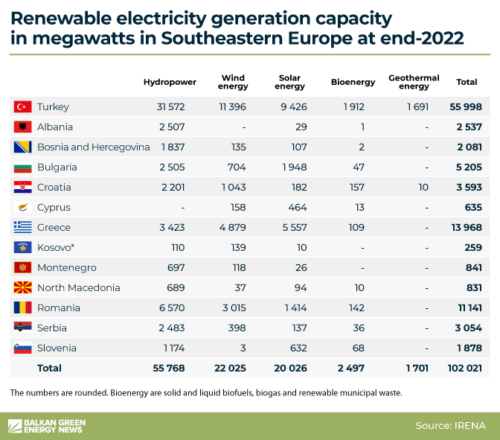
Photo: iStock
The world added a record 295 GW of renewable electricity capacity last year, increasing the stock by 9.6%, IRENA said. Photovoltaics, which accounted for almost two thirds, were also dominant in new installations in Southeastern Europe and rapidly accelerating. Green energy expansion in most countries in the region was slower than the global pace, but Bulgaria and Cyprus achieved stunning growth.
Renewables accounted for 40% of global installed power capacity at the end of last year. They must become the most significant factor, including in the context of grid flexibility and adaptation to variable power, according to the International Renewable Energy Agency.
In its Renewable Capacity Statistics 2023, the organization announced that the world added a record 295 GW, or 9.6% in 2022, reaching 3.37 TW. The share of green energy in total new power plant additions reached an unprecedented 87%.
But to stay on the pathway to limit the rise in global temperature to 1.5 degrees Celsius from preindustrial levels, the world needs to see more than 1 TW of annual renewable capacity additions until 2050, with solar power making up more than half, according to IRENA’s Director-General Francesco La Camera. A revised reading showed growth in 2021 was 9.4%.
China contributes almost half of growth in global renewables
Asia accounted for 59% of all new capacity in 2022, whereas China accounted for 141 GW. Renewables in Europe and North America grew by 57.3 GW and 29.1 GW, respectively.
Solar power made up almost two thirds of all new installations
Solar power alone accounted for a record 192 GW or almost two thirds of the total. Growth in the sector came in at 22% to 1.05 GW. There was 75 GW of wind energy added or 9%, compared to 93 GW from 2021 and 111 GW from 2020. The capacity reached 899 GW.
Hydropower remained the largest segment of the market, rising 2.2% to 1.39 TW. The figures include pumped storage. Total geothermal energy increased by just 1.2% to 14.9 GW. Kenya accounted for almost half of the net additions, 86 MW, followed by Indonesia (57 MW) and the United States (56 MW).
Turkey slows expansion
Turkey dwarfs the rest of Southeastern Europe with its renewable electricity capacity. The country was also regularly on global top lists in growth terms, but last year it saw a slowdown. Total renewables expanded 5.2% to 56 GW. Nevertheless, the nominal rise, 2.77 GW, is still impressive.
As with the rest of the region, solar power was the bright spot, adding 20.6% to hit 9.4 GW. Wind power in Turkey increased by 7.4% to 11.4 GW. The bioenergy item added a strong 16.8% to land at 1.9 GW, but geothermal energy, in which the country is fourth in the world, expanded by a meager 0.9% to 1.69 GW.
Greece achieved a 12.1% growth in total in the renewables sector, to 14 GW. Solar power capacity spiked 29.9% to 5.6 GW, compared with 4.9% for wind, to 4.9 GW.

Photovoltaics account for virtually entire increase in capacity in most Balkan countries
Bulgaria emerged as a significant player in the Balkans as its overall renewable electricity capacity surged 14.8% to 5.2 GW. IRENA attributed the entire growth to solar power. The sector expanded by a whopping 52.8% to 1.95 GW.
Cyprus posted an even more stunning increase, 30.9%, than in the previous year, when it achieved 21.3%. Total capacity reached 635 MW. Again, photovoltaics amounted for the entire rise, expanding 47.3% to 464 MW.
The only other market tracked by Balkan Green Energy News that beat the global growth rate was Slovenia, with 10.2% to 1.88 GW. Solar power accounted for virtually all additions, as the capacity advanced 37.1% to 632 MW.
The remaining countries of Southeastern Europe had weak or zero overall growth, while the board also showed some negative revisions against the figures from the previous reports. Romania inched higher to an otherwise strong 11.14 GW, of which solar power accounted for 1.41 GW against 3 GW in wind energy.
Photovoltaics were the only vibrant segment for the rest, though total solar power capacities remain modest. Montenegro saw a rise of 19 MW to 26 MW and Serbia added 85 MW to hit 137 MW. Bosnia and Herzegovina almost doubled its capacity to 107 MW and Croatia grew to 182 MW last year from 138 MW. Kosovo* was left unchanged at 10 MW.
Total renewable electricity capacity in North Macedonia was revised downward by 132 MW for 2021 to 831 MW and left unchanged in the new report
The photovoltaic capacity in Albania increased by just 6 MW to 29 MW. In IRENA’s statistics, North Macedonia had no growth in total renewables, remaining at 831 MW. The organization even downgraded the overall size, as last year it said the country had 963 MW in renewables in 2021, but now the figure for hydropower was revised. The new report showed solar power flat at 94 MW, the same as in the previous edition, despite the commissioning of significant solar power capacity.
Most Balkan countries have a share of renewable electricity plants higher than the world’s 40%, the report revealed. Albania and Montenegro are ranked the highest, with 96.3% and 78.9%, respectively, followed by Croatia’s 72.4%. Serbia (35.1%) and Kosovo* (16.7%) are the only ones below the line.


















Be the first one to comment on this article.